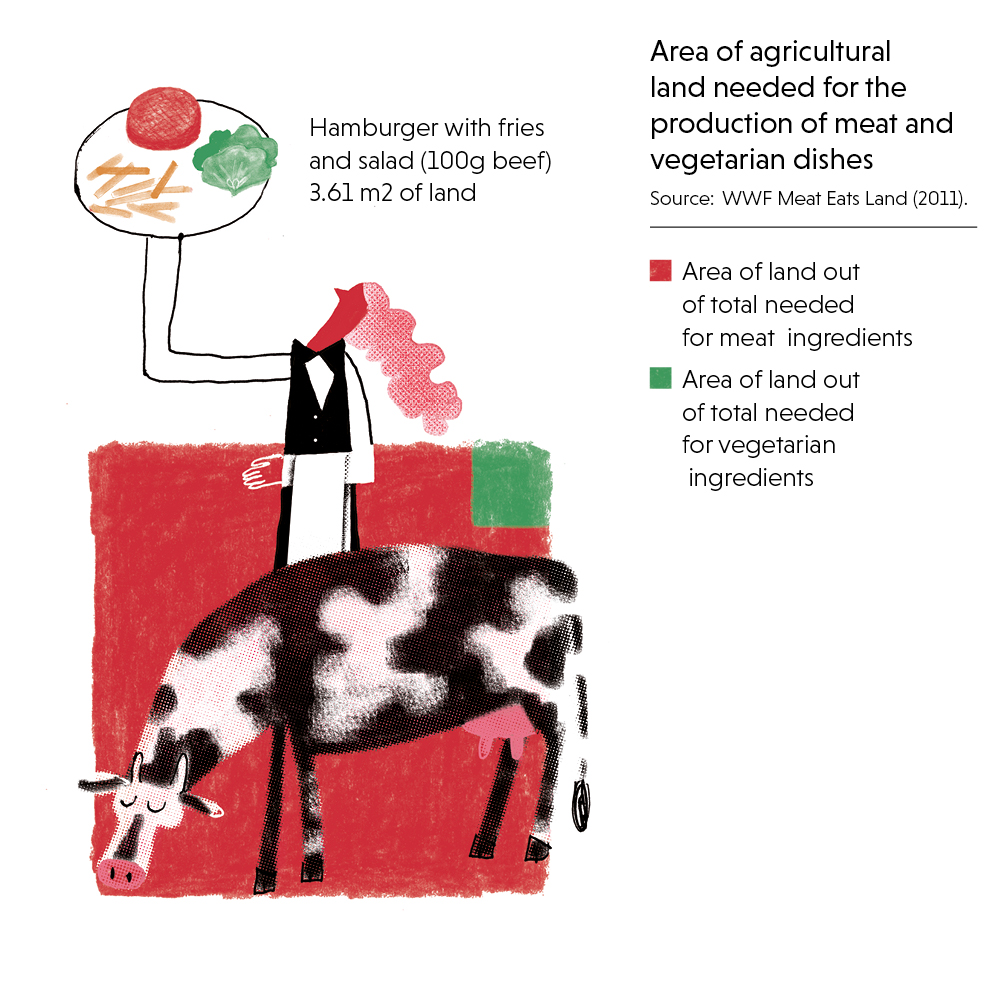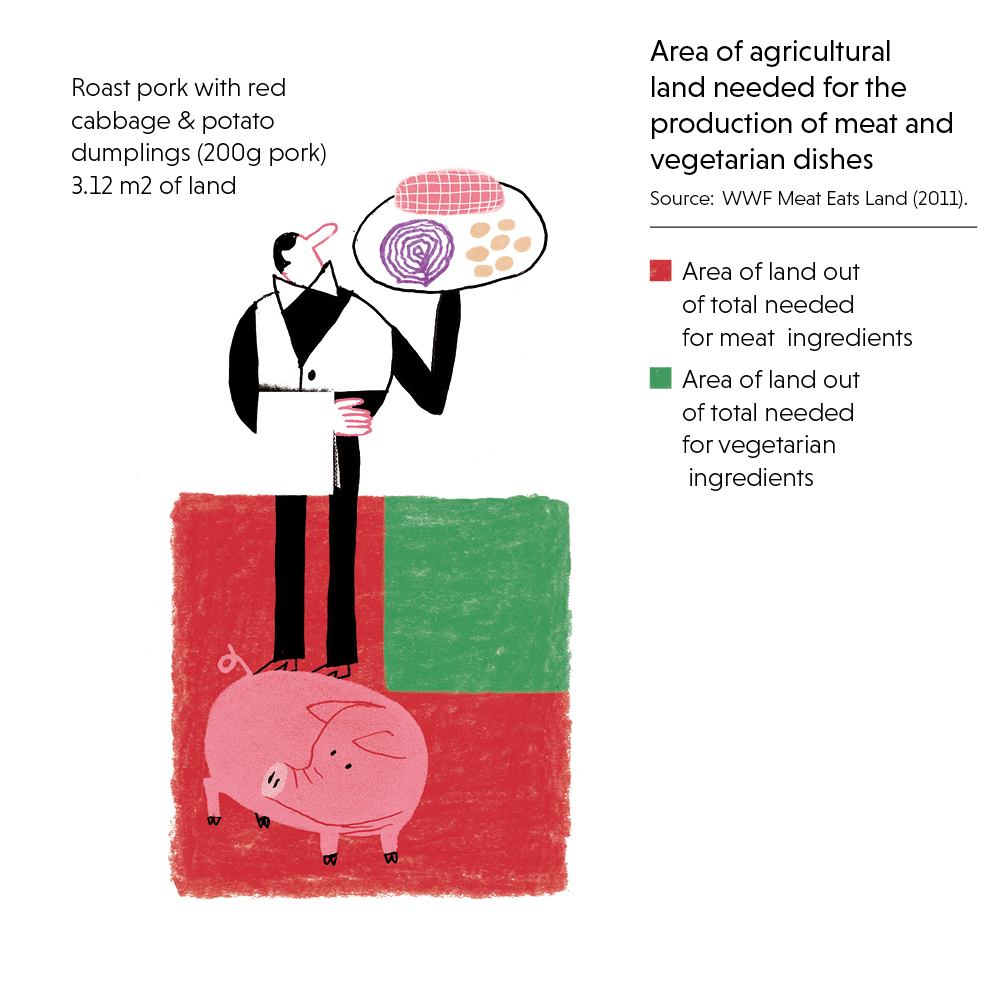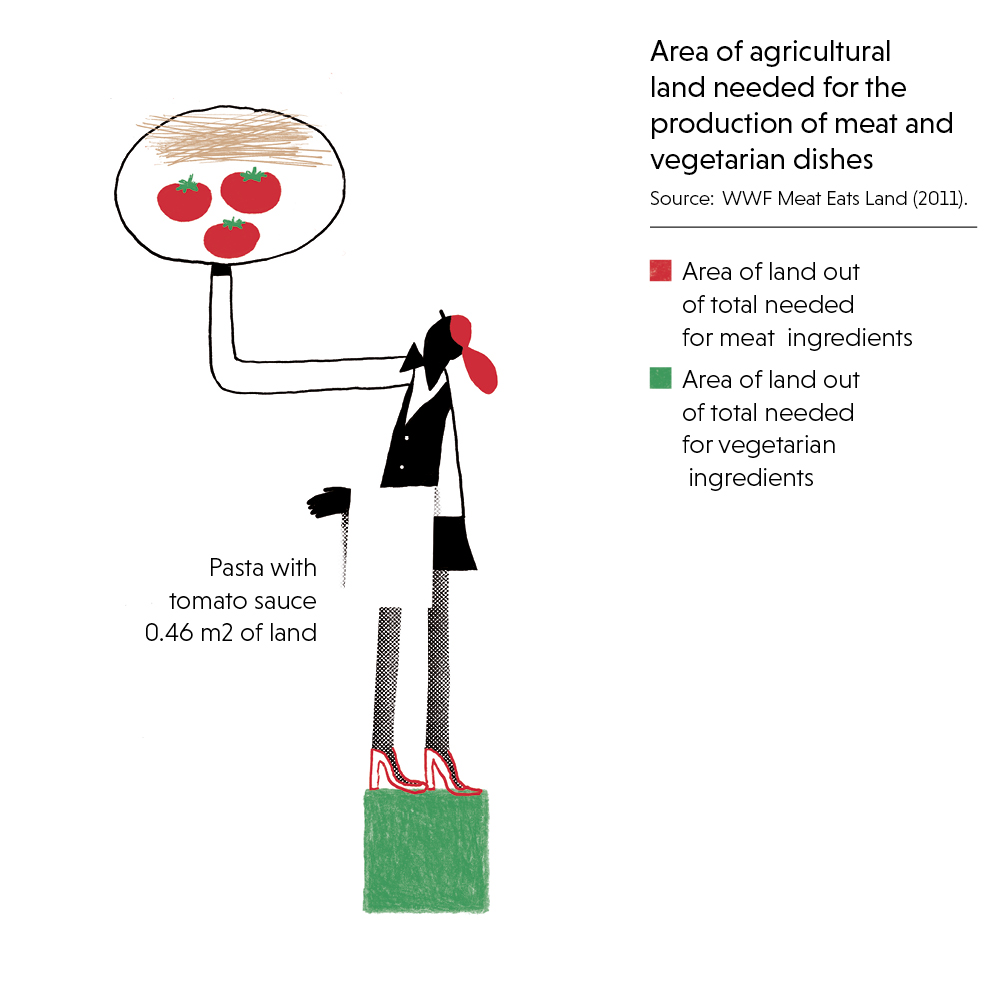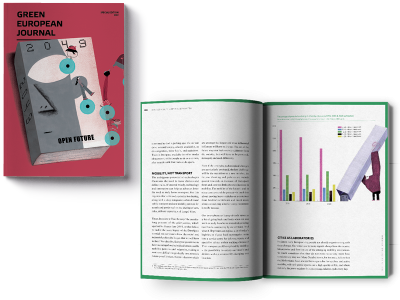The food system of the future will not be controlled by farmers or consumers, but built around their cooperation. Getting to know each other better and understanding the other’s point of view is a big part of this process. Let’s explore the methods of those taking the first steps, in 2019, towards an agriculture that gets farmers the most out of their land whilst letting nature shoulder its share of the work. Who knows, by 2049 agroecology could be the dominant model of farming in Europe.
If any single reform is to be made of our food and environmental systems by 2049, it is that of agriculture. Farming today remains a 20th-century relic, despite the emergence of different ways of farming (and of thinking about farming) striving to gain the upper ground. Professor Olaf Schmidt, an eminent researcher on agricultural systems at University College Dublin (and, like Charles Darwin, an expert on worms), dreams of “a farming system which would provide farmers with profitable and rewarding work that sustains rural communities. Such a system would produce safe, nutritional food for all and would protect the earth, water resources, biodiversity, the air, and landscape.” Professor Schmidt is clear that while “scientists have a role to play as they can carry out in-depth analyses into farming methods, all innovations should be passed along to farmers first and foremost.” The system the researcher describes is currently referred to as ‘agroecology’, the application of ecology in agriculture. The principles of agroecology are: take care of the soil, recycle organic materials, reduce waste, make use of services provided by nature, encourage biodiversity, and, last but not least, financial autonomy for farmers.

When Bernard Mehauden, a middle-aged Belgian farmer, began to apply a mixture of agricultural knowledge and intuition to the industrial farming model that he had inherited, it did not occur to him that he was becoming a practitioner of agroecology. But no longer sticking to received formulas, Bernard now farms following his own ideas and those that he shares with his fellow farmers. These experiments are leading him down an increasingly ecological path. Bernard calls his farming “eco-logical”, but it is not certified organic. He avoids niche markets and distributes via traditional sales channels to avoid worrying about marketing.
It all starts with the soil
Bernard Mehauden grows cereals on a larger-than-average Belgian farm. Situated on the loamy plateaus around Hesbaye in the Liège region, his is some of the best farmland in the country. Not far from Europe’s biggest centres for beetroot and field vegetable processing, Bernard’s operation would not seem to be a typical candidate for adopting agroecology. But his beautiful plots, soil well refined just waiting for the seeds to be sown, fell victim to a harmful phenomenon: crusting. Crusting occurs when particles in the soil stick together after the sowing of the seeds and prevent seedlings from breaking through. Desperate to find a solution, Bernard’s first step was to stop ploughing his fields. He is now convinced that he took the right decision: “15 years ago, when I understood that leaving organic matter on the surface would protect the soil, I completely stopped ploughing. Nowadays, just looking at a plough is enough to break my heart”.
Is farming in Belgium moving towards agroecology?
There are around 35 000 agricultural holdings in Belgium. In Flanders, farming tends to use industrial methods for high-value production on smaller plots of land. Wallonia has a more intermediate model whereby crops are grown on larger fields and animals are reared less intensively. Although the average size of a farm in Wallonia is 57 hectares (according to 2017 figures), farmers growing field crops will typically raise them on plots of land of around 100 hectares.
No figures are currently available on the number of farmers using agroecological methods in Wallonia. Maxime Merchier, coordinator of Belgian association Greenotec which promotes soil-friendly farming, puts the number for Belgium at around 10 per cent. Most of these practise agroecology out of conviction and because they wish to put their knowledge of the soil back to work and return to common sense. This estimate would include most of Belgium’s organic farmers, as well as farmers focused on soil conservation, self-sufficient livestock farmers, and permaculture farmers. Why are the numbers so low? At the heart of the problem is the system of globalised agriculture put in place at the European level. Farmers produce at a loss and survive only thanks to aid from the EU’s Common Agricultural Policy. Farmers are stuck in a vicious circle, forced to produce at low cost.
Merchier sums up the situation: “For decades,farmers were pushed towards a productivist agricultural system built entirely around yields. This system depletes soils, pollutes water resources, and consumes high amounts of fossil fuels.”“In contrast, agroecology looks to the future. It is not only farmers that benefit in the medium to long term; agroecology is also beneficial for the surrounding areas and for society in general. It is an agriculture of the living – its objective is to guide ecosystem services to make the most of nature to support agricultural production. Such a profound change in our farming model will take time. The transition is harder because the benefits are not immediate. Investments in training and equipment are necessary, as is a change in mentality, and it does represent a certain risk for the farmer. In our globalised world sales prices are volatile, making it even more difficult for farmers to take the plunge.”
Crop rotation is ensured through alternating wheat, a winter crop, with spring crops such as sugar beet, flax for textiles, peas for canning, and chicory for producing inulin. Bernard rotates his crops once every two years. He also farms grain corn at times, a back-up solution during periods of bad weather. If it rains in the autumn when the wheat must be sown then it is best to avoid heavy machinery, which would pack the soil down, and to wait for spring and plant corn. “It’s not as profitable but it’s better for the soil. Either you wait for the right weather to go into the fields or you find another solution,” says our farmer, demonstrating his main principle: adaption.
Feeding the soil
During the winter months, all of Bernard’s farmland is covered, either with a winter crop or with a cover crop not to be harvested but to feed the soil. Organic cover crops are one of agroecology’s main pillars. A soil full of life effectively provides services that help farmers and permit them to reduce their reliance on fertiliser and pesticides. Covers are made up of multiple plant species and contain at least one legume. A diversity of cover species means a diversity of services for the soil too.

Having stopped ploughing to protect his soil and let the microscopic biodiversity build up year on year, Bernard cannot count on the plough to destroy his cover crops either. But to make space for the next crop, the cover must be removed somehow. Bernard looks to the frost to do this work for him. Before and after raising crops for sale, Bernard plants crops that are sensitive to frost and that will die off in the winter, which should mean that he will not have to use weed killer in the spring. Things, of course, do not always go as planned. Recent winters have been warmer than usual and species meant to die during the winter are, rather annoyingly, making it through to spring. He thus helps nature to destroy his cover by breaking it up with a mounted disc harrow.
Once winter comes, Bernard waits for the soil to become ‘load-bearing’ before working it. Load-bearing soil is one on which equipment can be used without it sinking into the earth, packing down the soil and making ruts. For roots to grow well, air, water, and life must be able to move around inside the soil. For a soil that is full of life, farmers must adapt to the weather and wait for the right moment to work the fields. So during the overnight frost, Bernard sometimes has to wake at 3 a.m. to use his mounted disc harrow. The tool damages stems, making plants more vulnerable to the cold. Bernard avoids using glyphosate herbicide whenever he can. However, if a new growth of weeds appear at the end of the winter in cover that was meant to be destroyed by frost, he uses a small amount (one litre per hectare) before sowing any seeds.

Less is more
Since he started to plant sugar beets, Bernard has reduced the amount of mineral nitrogen he spreads on his fields by half whilst maintaining the same yields. This is partly down to an improvement in sugar beet varieties, which now produce more sugar and consume less nitrogen. But the main part of this reduction in nitrogen is down to Bernard’s plan for a more fertile soil, pursued on the basis of a soil analysis carried out by expert organisations.
Bernard has also reduced his use of phytosanitary products, or pesticides. He frowns ever so slightly as he tells us, “I use the absolute minimum amount of phytos, basically because I just don’t like using them.” He chooses the best possible time of year for spraying pesticides in his fields to ensure optimal impact and to minimise the necessary dose. “I don’t need to use any products to protect from slugs as I don’t have any here, but I don’t have rapeseed. I don’t need anything for field mice either, as there are not many in my fields. I’ve put perches up for birds of prey: a 2-metre long stick with a slat across it. There’s one perch for every second hectare and I’ve seen birds of prey perched on them.” Birds of prey help control the rodent population. A family of harriers eat between 700 and 900 rodents per year, at least during the months when they are in the area. Putting a perch up to help such birds survey the fields costs farmers much less than the damage rodents can cause.

This situation is even more complex due to European legislation banning the use of fertilisers and pesticide within 6 metres of bodies of running water. To make the most out of what could be seen as a restriction, Bernard is taking part in an environmental initiative called bande de parcelle aménagée [strips of converted land] for which he receives 1500 euros per hectare to convert the edges of his land that lie alongside a stream. This initiative aims to support wildlife, conserve meadow flora, improve the landscape, and fight erosion. Thanks to his strip, which is 12 metres wide and 385 metres long, Bernard helps to protect the partridge and the corn bunting, birds dependent on plant species at risk of disappearance. The strip offers these birds tall grasses for cover, grains that fall naturally, and plants full of insects in summer and grains in winter.
Ever-curious, Bernard has started to use certain plant-based products: “I’ve been testing them on wheat for about 10 years now. I’m not 100 per cent convinced but I’m interested in the idea. These products have allowed me to reduce the amount of fungicide I use on my wheat by 75 per cent.” The cost of the plant-based products is counterbalanced by the reduced need for fungicide. Bernard explains, “The idea is not about saving money but about using less fungicide and protecting the soil.”

Last summer, after the pea harvest, Bernard planted a multi-species cover made up of phacelia, mustard, sunflowers, Egyptian clover, fava beans, and nyger seeds. In the autumn, for the first time he planted wheat straight into the cover, without destroying it first. To do this he used a direct seeder provided by Regenacterre, an association that promotes regenerative agriculture. “The neighbours looked at me like I was crazy when I was sowing the seeds, but it was a great experience and I’d love to do it again,” recounts Bernard. “Direct seeding was something I had been dreaming of doing for a while but I didn’t have the right seeder. One of the challenges is that you need very clean soil before sowing the cover and the cover also has to be dense enough to prevent weeds from growing because you cannot clear them before winter. The weeds protected by the cover destroyed during seeding can come back in force in the spring. After sowing the wheat, mustard plants sprouted up and I had to use two litres of Round Up (a glyphosate-based herbicide) per hectare to stop them growing and flowering. Ideally, I would have used a chopper in front of the seeder to properly remove the cover, but I don’t have one.”
Listening, learning and trying new things
“We have to make this transition slowly but surely. In the future, I would like my soil to be even more full of life. To make that happen, I’ll have to keep on reducing the use of phytos, increasing quantities of organic matter, and avoid deep working of the soil. I would like to try intercropping, there are many possibilities to explore there. It would be great for researchers to look into intercropping with sugar beet, chicory, corn, and grains.” When we asked Bernard to tell us what he was proud of on his farm he answered, “I’m improving the biological worth of my soil and that’s important for future generations. I’ll be proud to pass on a soil that is both fertile and alive.”

